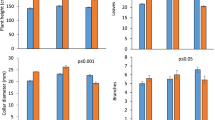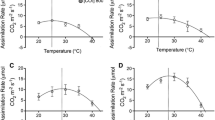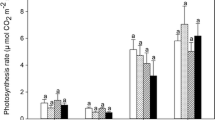Abstract
Several studies have been conducted on the response of crops to greater concentrations of atmospheric CO2 (CO2 fertilization) as a result of climate change, but only few studies have evaluated this effect on multipurpose agroforestry tree species in tropical environments. The objectives of this study were to quantify differences in growth parameters and in leaf carbon (C) and nitrogen (N) concentrations of Cedrela odorata L. and Gliricidia sepium (Jacq.) Walp. seedlings under current ambient temperature (32°C daytime, 22°C night time) and CO2 (360 ppm) (AMB); CO2 fertilization (800 ppm, 32°C daytime, 22°C night time) (fCO2); elevated ambient temperature (360 ppm, 34°C daytime, 25°C night time) (TEMP); and a combination of elevated temperature (32°C daytime, 22°C night time) and CO2 fertilization (800 ppm) (TEMPxfCO2). Results showed significant differences (P < 0.05) in seedling growth parameters (seedling height, number of stem leaves, leaf area ratio, shoot and root biomass, and shoot/root ratio) between treatments for both tree species. The greatest increases in growth parameters occurred in the TEMP and TEMPxfCO2 treatments compared to the AMB treatment for both tree species. However, growth parameters were significantly lower (P < 0.05) in the fCO2 treatment compared to that of the AMB treatment. Leaf N concentration was 1.1 to 2.1 times lower (P < 0.05) in all treatments when compared to current ambient conditions (AMB) in both tree species, but no significant changes in leaf C concentrations were observed. Results from our study suggested that fCO2 had the greatest negative impact on tree growth parameters, and leaf N concentrations were affected negatively in all treatments compared to current ambient conditions. It is expected that such changes in growth parameters and plant N content may impact the long-term cycling of nutrients in agroforestry systems.


Similar content being viewed by others
References
Ainsworth EA, Long SP (2005) What have we learned from 15 years of free-air CO2 enrichment (FACE)? A meta-analysis review of the responses of photosynthesis, canopy. New Phytol 165:351–371
Allen LH, Vu JCV (2008) Carbon dioxide and high temperature effects on growth of young orange trees in a humid, subtropical environment. Agr Forest Meteorol 149:820–830
Beerling DJ, Fry JC (1990) A comparison of the accuracy, variability and speed of five different methods for estimating leaf area. Ann Bot London 65:483–488
Bradley KL, Pregitzer KS (2007) Ecosystem assembly and terrestrial carbon balance under elevated CO2. Trends Ecol Evol 10:538–547
Carswell FB, Grace J, Lucas ME, Jarvis PG (2000) Interaction of nutrient limitation and elevated CO2 concentration on carbon assimilation of a tropical tree seedling (Cedrela odorata). Tree Physiol 20:977–986
Clark DA (2004) Sources or sinks? the responses of tropical forests to current and future climate and atmospheric composition. Philos Trans Royal Soc B 359:477–491
Cotrufo MF, De Angelis P, Polle A (2005) Leaf litter production and decomposition in a poplar short-rotation coppice exposed to free air CO2 enrichment (POPFACE). Glob Change Biol 11:971–982
Cox PM, Betts RA, Jones CD, Spall SA, Totterdell LJ (2000) Acceleration of global warming due to carbon-cycle feedbacks in coupled climate models. Nature 408:184–187
Cramer W, Bondeau A, Schaphoff S, Lucht W, Smith B, Sitch S (2004) Tropical forests and the global carbon cycle: impacts of atmospheric carbon dioxide, climate change and rate of deforestation. Philos Trans Royal Soc B 359:331–343
Gebauer R, Reynolds J, Strain BR (1996) Allometric relations and growth in Pinus taeda: the effect of elevated CO2 and changing N availability. New Phytol 134:85–93
Gielen B, Calfapietra C, Sabatti M, Ceulemans R (2001) Leaf area dynamics in a closed poplar plantation under free-air carbon dioxide enrichment. Tree Phys 21:1245–1255
Hoorens B, Aerts R, Stroetenga M (2003) Is there a trade-off between the plant’s growth response to elevated CO2 and subsequent litter decomposability? Oikos 105:17–30
Hui D, Sims DA, Johnson DW, Cheng W, Luo Y (2002) Effects of gradual versus step increases in carbon dioxide on Plantago photosynthesis and growth in a microcosm study. Environ Exp Bot 47:51–66
Intergovernmental Panel for Climate Change (IPCC) 2007. Climate change 2007-the physical science basis, contribution of working group I to the fourth assessment report of the IPCC
Keller M, Lerdau M (1999) Isoprene emission from tropical forest canopy leaves. Glob Biogeochem Cycles 13:19–29
Khurana EKTA, Singh JS (2001) Ecology of seed and seedling growth for conservation and restoration of tropical dry forests: a review. Environ Conserv 28:39–52
Körner C (2004) Through enhanced tree dynamics carbon dioxide enrichment may cause tropical forests to lose carbon. Philos Trans Royal Soc B 443:493–498
Körner C (2009) Responses of humid tropical trees to rising CO2. Annu Rev Ecol Syst 40:61–79
Lee JS (2011) Combined effect of elevated CO2 and temperature on the growth and phenology of two annual C3 and C4 weedy species. Agr Ecosyst Environ 140:484–491
Lewis SL, Lloyd J, Sitch S, Mitchard ETA, Laurance WF (2009) Changing ecology of tropical forests: evidence and divers. Annu Rev Ecol Syst 40:529–549
Lindroth RL (2010) Impacts of elevated atmospheric CO2 and O3 on forests: phytochemistry, trophic interactions and ecosystem dynamics. J Chem Ecol 36:2–21
Liu L, King JS, Brooker FL, Giardina CP, Allen HL, Hu S (2009) Enhanced litter input rather than changes in litter chemistry drive soil carbon and nitrogen cycles under elevated CO2: a microcosm study. Glob change Biol 15:441–453
Lloyd J, Farquhar GD (2008) Effects of rising temperatures and [CO2] on the physiology of tropical forest trees. Philos Trans Royal Soc B 363:1811–1817
Lovelock CE, Virgo A, Popp M, Winter K (1999) Effects of elevated CO2 concentrations on photosynthesis, growth and reproduction of branches of the tropical canopy tree species, Luehea seemannii Tr. and Planch. Plant Cell Environ 22:49–59
Lukac M, Calfapietra C, Lagomarsino A, Loreto F (2010) Global climate change and tree nutrition: effects of elevated CO2 and temperature. Tree Physiol 1093:1–12
Markesteijn L, Poorter L (2009) Seedling root morphology and biomass allocation of 62 tropical tree species in relation to drought- and shade-tolerance. J Ecol 97:311–325
Na L, Genxu W, Yan Y, Yongshen G, Guangsheng L (2011) Plant production, and carbon and nitrogen source pools, are strongly intensified by experimental warming in alpine ecosystems in the Qunghai-Tibet plateau. Soil Biol Biochem 43:942–953
Nair PKR (1993) An introduction to agroforestry. Kluwer, Dordrecht
Norby RJ, Warren JM, Iversen CM, Medlyn BE, McMurtrie RE (2010) CO2 enhancement of forest productivity constrained by limited nitrogen availability. Proc Natl Acad Sci USA 107:19368–19373
Oelbermann M, Voroney RP, Kass DCL (2004) Gliricidia sepium carbon inputs and soil carbon pools in a Costa Rican alley cropping system. Int J Agri Sustain 2:33–42
Oelbermann M, Voroney RP, Kass DCL, Schlönvoigt AM (2005) Above- and below-ground carbon inputs in 19-, 10-, and 4-year old Costa Rican alley cropping systems. Agr Ecosyst Environ 105:163–172
Overdieck D, Ziche D, Bottcher-Jungclaus K (2007) Temperature response of growth of wood anatomy in European beech saplings grown in different carbon dioxide concentrations. Tree Physiol 27:261–268
Raizada P, Singh A, Raghubanshi AS (2009) Comparative response of seedlings of selected native dry tropical and alien invasive species to CO2 enrichment. J Plant Ecol 2:69–75
Rogers A, Gibon Y, Stitt M, Morgan PB, Bernacchi CJ, Ort DR, Long SP (2006) Increased C availability at elevated carbon dioxide concentration improves N assimilation in a legume. Plant Cell Environ 29:1651–1658
Scarascia-Mungozza G, De Angelis P, Sabatti M, Calfapietra C, Miglietra F, Raines C, Godbold D, Hoosbeek M, Taylor G, Polle A, Ceulemans R (2005) Global change and agro-forest ecosystems: adaptation and mitigation in a FACE experiment on a poplar plantation. Plant Biosyst 139:253–264
Shenglei F, Ferris H (2006) Plant species, atmospheric CO2 and soil N interactively or additively control C allocation within plant-soil systems. Sci China Ser C 49:603–612
Sigurdsson BD, Thorgeirsson H, Linder S (2001) Growth and dry matter partitioning of young Populus trichocarpa in response to carbon dioxide concentration and mineral nutrient availability. Tree Physiol 21:941–950
Steel GD, Torrie JH, Dickey DA (1997) Principles and procedures of statistics: a biometrical approach. McGraw-Hill, NY
Thomas RB, Strain BR (2000) Root restriction as a factor in photosynthetic acclimation of cotton seedlings grown in elevated carbon dioxide. Plant Physiol 96:627–634
Tissue DT, Megonigal JF, Thomas RB (1997) Nitrogenase activity and N2 fixation are stimulated by elevated CO2 in a tropical N2-fixing tree. Oecologia 109:1–28
Tupker KA, Thomas BR, Macdonald SE (2003) Propagation of trembling aspen and hybrid poplar for agroforestry: potential benefits of elevated CO2 in the greenhouse. Agrofor Sys 59:61–71
Walther GR, Post E, Convey P, Menzel A, Parmesan C, Beebee TJC, Formentin JM, Hoegh-Gugdberg O, Bairlein F (2002) Ecological responses to recent climate change. Nature 416:389–395
Warren R, Price J, Fischlin A, de la Nava Santos S, Midgley G (2011) Increasing impacts of climate change upon ecosystems with increasing global mean temperature rise. Climat Change 106:141–177
Wertin TM, McGuire MA, Teskey RO (2009) The influence of elevated temperature, elevated atmospheric CO2 concentration and water stress on net photosynthesis of loblolly pine (Pinus taeda L.) at northern, central and southern sites in its native range. Glob Change Biol 16:2089–2103
Wurth MKR, Winter K, Körner CH (1998) In situ responses to elevated CO2 in tropical forest understory plants. Funct Ecol 12:886–895
Xiao CW, Sun OJ, Zhou GS, Zhao JA, Wu G (2005) Interactive effects of elevated CO2 and drought stress on leaf water potential and growth in Caragana intermedia. Trees 19:711–720
Zieche D, Overdieck D (2004) CO2 and temperature effects on growth, biomass production, and stem wood anatomy of juvenile Scots pine (Pinus sylvestris L.). J Appl Bot Angew Bot 78:120–132
Acknowledgments
We thank the Natural Sciences and Engineering Research Council of Canada (NSERC) and the Inter-American Institute for Cooperation on Agriculture Canada (IICA-Canada) for providing financial assistance for this study.
Author information
Authors and Affiliations
Corresponding author
Rights and permissions
About this article
Cite this article
Esmail, S., Oelbermann, M. The impact of climate change on the growth of tropical agroforestry tree seedlings. Agroforest Syst 83, 235–244 (2011). https://doi.org/10.1007/s10457-011-9424-1
Received:
Accepted:
Published:
Issue Date:
DOI: https://doi.org/10.1007/s10457-011-9424-1




